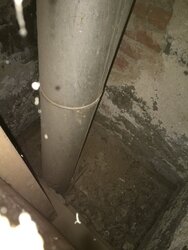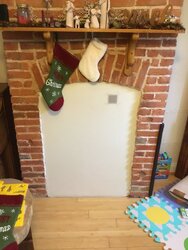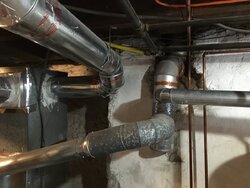Hello. About 3 years ago I bought a 3 story rowhouse in Philadelphia. I believe it is about 100 years old. It is as quirky as they come. The living room ‘fireplace’ has a sheet of drywall to hide the fact that the furnace in the basement (a modern natural gas, forced-air system) runs its vent pipe up through the floor of the fireplace and out the top of the chimney. I want to 1) reroute the furnace vent pipe and 2) install a natural gas fireplace insert to make our living room look nicer and more intentional. I called a local fireplace company and showed them these photos and they told me they wanted nothing to do with it. Any suggestions? Know anyone who’s creative and up for a challenge? (Photo 1: I cut a hole into the fireplace cover and took this. You can see the vent pipe running up through the space. Photo 2: how the fireplace looks in the living room( with hole for previous photo covered by cardboard square). Photo 3: the furnace vent pipe entering the bottom of the chimney - someone must have chiseled a hole for this purpose when installing the furnace).
Help with rowhouse fireplace
- Thread starter Ecj506
- Start date
-
Active since 1995, Hearth.com is THE place on the internet for free information and advice about wood stoves, pellet stoves and other energy saving equipment.
We strive to provide opinions, articles, discussions and history related to Hearth Products and in a more general sense, energy issues.
We promote the EFFICIENT, RESPONSIBLE, CLEAN and SAFE use of all fuels, whether renewable or fossil.
You are using an out of date browser. It may not display this or other websites correctly.
You should upgrade or use an alternative browser.
You should upgrade or use an alternative browser.
Looks like there are 3 appliances on that vent. (furnace, hw and ? (dryer?)). That makes a solution more complicated.
Looks like there are 3 appliances on that vent. (furnace, hw and ? (dryer?)). That makes a solution more complicated.
It’s 2 appliances - the hot water heater (to the right) and the heater (to the left).
Yes, both will need alternative venting solutions. Then the fireplace base needs restoration. Then proper venting for the gas fireplace needs to be in place, then the gas logs need to be plumbed and installed.
SpaceBus
Minister of Fire
What are the manufacturer's requirements for venting your current appliances? Perhaps the 30+ of liner is not necessary and they can be vented on a much shorter run through an exterior wall.
spudman99
Feeling the Heat
What you are asking to do will be pretty difficult. Having been thru hundreds of Philly rowhomes over the last 20 years, I do not think I have seen 1 with an operating fireplace unless it was a stately and large home on Dickenson or in Rittenhouse Square. Also I bet the City inspectors will have no clue as to what is proper and give you a real hassle (unless of course they like the special envelopes with Benjamins laying on the floor...hehe).
One method that might work is if you can relocate the vent pipe to the side of the fireplace, but that will require the installation of an enclosed chase which would not look all that great in the rowhouse (I'm assuming its 16' wide). Then install a ventless gas log unit in the existing fireplace hooked to the natural gas. No flue is needed for that setup and it doesn't look too bad.
Keep in mind that you will not recoup any cost in the term of increased value by having a working fireplace. Just not common enough in the City to drive demand. It is nice and if you like it; and you can afford it; then go for it. Just do not expect any payback.
One method that might work is if you can relocate the vent pipe to the side of the fireplace, but that will require the installation of an enclosed chase which would not look all that great in the rowhouse (I'm assuming its 16' wide). Then install a ventless gas log unit in the existing fireplace hooked to the natural gas. No flue is needed for that setup and it doesn't look too bad.
Keep in mind that you will not recoup any cost in the term of increased value by having a working fireplace. Just not common enough in the City to drive demand. It is nice and if you like it; and you can afford it; then go for it. Just do not expect any payback.
SpaceBus
Minister of Fire
Ventless anything is horrible. I don't miss my propane range oven.As spudman said you would have to relocate the vent and enclose it in a chase. At that point you could install a vented gas insert with intake and exhaust liners. I would never recommend a ventless unit
spudman99
Feeling the Heat
You can vent it up through the chimney like you do with most gas inserts. Yes you have to pay attention to the height of the chimney and pic a unit that will work with your height but it is absolutely doable. I have done it many times. Even a few in row homesThere is no way to install a vented unit in a rowhouse. Party walls on both sides and as a 3 story unit the roof is probably 25' up. No convenient means of accessing an exterior wall. I suspect the OP will read our comments and not return.
Probably looks something like this
View attachment 253796
It would be a major project, but... It'd be possible to route the water heater and furnace out the back wall. This might require physically moving the appliances and maybe upgrading them.
Then you can start looking into the fireplace.
Question for @bholler. Could a pellet stove flue be run up the chimney and be minimally invasive?
Then you can start looking into the fireplace.
Question for @bholler. Could a pellet stove flue be run up the chimney and be minimally invasive?
Yes but many of them have height restrictions as well. You just have to make sure the stove you are looking at will work with your heightIt would be a major project, but... It'd be possible to route the water heater and furnace out the back wall. This might require physically moving the appliances and maybe upgrading them.
Then you can start looking into the fireplace.
Question for @bholler. Could a pellet stove flue be run up the chimney and be minimally invasive?
lml999
Minister of Fire
When we moved into our new (to us) house, I found that the previous owner had replaced the original gas fired hot water heater with a larger one too tall for the flue configuration.. We were getting combustion gases backdrafting into the basement. Yea, our hot water heater was trying to kill us. So I ripped out the hot water heater and converted to an indirect SuperStor (heated by the boiler.)
Only one gas appliance (the boiler), only one flue necessary.
If you're reconfiguring, you might want to consider doing the same...
Only one gas appliance (the boiler), only one flue necessary.
If you're reconfiguring, you might want to consider doing the same...
There is only one flue required for their current equipmentWhen we moved into our new (to us) house, I found that the previous owner had replaced the original gas fired hot water heater with a larger one too tall for the flue configuration.. We were getting combustion gases backdrafting into the basement. Yea, our hot water heater was trying to kill us. So I ripped out the hot water heater and converted to an indirect SuperStor (heated by the boiler.)
Only one gas appliance (the boiler), only one flue necessary.
If you're reconfiguring, you might want to consider doing the same...
Doing that in row homes can be very difficultMight be time to consider a good, high-efficiency gas condensing furnace, especially if the old one is a basic 80% model. They can be vented out the side of the house with PVC pipe.
Can be. Just speculating without knowing the location of anything in the building.Doing that in row homes can be very difficult
Last edited:
When I replaced my boiler, I went with a wall hang unit. It's about the size of a piece of luggage. It could be placed anywhere. But the OP had forced hot air.
Once again, this points to a major project and the reason the stove shop couldn't run away fast enough.
Once again, this points to a major project and the reason the stove shop couldn't run away fast enough.
Thanks everyone for the detailed replies. Looks like this idea probably won’t get off the ground for all the reasons you guys mentioned.
But just curious, can someone who criticized a ventless natural gas fireplace insert give their reasons? I have a neighbor (also with an old rowhouse and a nonfunctional fireplace/chimney, but without the heater vent pipe running up through it) who installed that type of unit in his fireplace (he sealed off the top of the fireplace space with a cement board) and says it works great and he was very happy with it.
But just curious, can someone who criticized a ventless natural gas fireplace insert give their reasons? I have a neighbor (also with an old rowhouse and a nonfunctional fireplace/chimney, but without the heater vent pipe running up through it) who installed that type of unit in his fireplace (he sealed off the top of the fireplace space with a cement board) and says it works great and he was very happy with it.
SpaceBus
Minister of Fire
Thanks everyone for the detailed replies. Looks like this idea probably won’t get off the ground for all the reasons you guys mentioned.
But just curious, can someone who criticized a ventless natural gas fireplace insert give their reasons? I have a neighbor (also with an old rowhouse and a nonfunctional fireplace/chimney, but without the heater vent pipe running up through it) who installed that type of unit in his fireplace (he sealed off the top of the fireplace space with a cement board) and says it works great and he was very happy with it.
@DAKSY is the local gas fireplace expert. They scare me due to the poor air quality.
They are not ventless they are room vented. Most have limitations on length of time they can be used and many want a window cracked openThanks everyone for the detailed replies. Looks like this idea probably won’t get off the ground for all the reasons you guys mentioned.
But just curious, can someone who criticized a ventless natural gas fireplace insert give their reasons? I have a neighbor (also with an old rowhouse and a nonfunctional fireplace/chimney, but without the heater vent pipe running up through it) who installed that type of unit in his fireplace (he sealed off the top of the fireplace space with a cement board) and says it works great and he was very happy with it.
I've got a couple of ventless units that work very well. I don't run them when people are sleeping and have Co detectors in the rooms. They have never registered detectable Co fwiw. They do put out a good bit of h2o, which is a bonus for me in the winter..,
spudman99
Feeling the Heat
My ventless unit in a masonry fireplace has a built in Oxygen Depletion sensor to shut off, plus CO2 detectors near the bedrooms. It puts a good amount of heat into the room and is clean (propane is the fuel). During power outages it makes the room warm for sure. Logs were not cheap but it works well when in use.
Similar threads
- Replies
- 4
- Views
- 894
- Replies
- 1
- Views
- 511
- Replies
- 6
- Views
- 407
- Replies
- 13
- Views
- 1K





